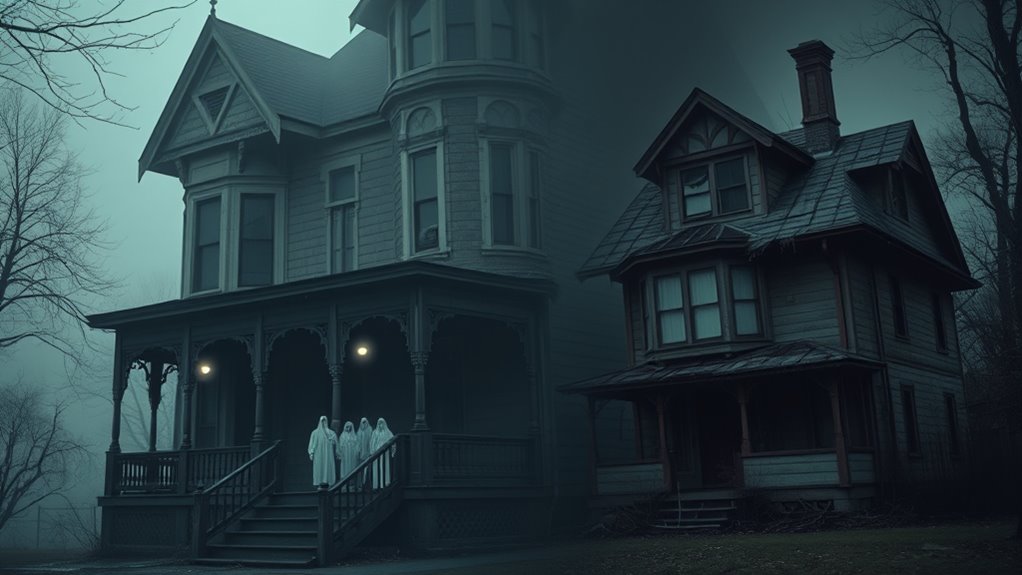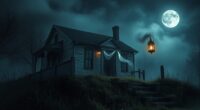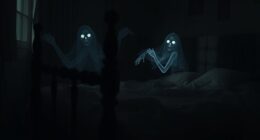Many believe ghosts only haunt old houses, but that’s a myth. Spirits can appear anywhere — modern buildings, recent tragedy sites, even busy urban areas. Hauntings often relate to emotional energy or unresolved trauma, which isn’t limited by age. Environmental factors, psychological perceptions, and recent events can all attract spirits to new or recently vacated places. If you want to uncover what truly draws spirits, there’s more to explore below.
Key Takeaways
- Ghost sightings are reported in both old and modern locations, not limited to ancient houses.
- Residual energies from recent trauma can cause hauntings in newly abandoned or active sites.
- Psychological factors and environmental stimuli can create paranormal perceptions anywhere, regardless of age.
- Modern places like hospitals, schools, and battlefields also have documented ghost phenomena.
- The myth that spirits only haunt old houses is false; spirits can manifest in any environment with emotional or traumatic significance.
The Origins of the Haunted House Myth

Have you ever wondered where the idea of haunted houses first came from? It all stems from superstitious beliefs that people held centuries ago. Many cultures believed spirits lingered in places where tragic events occurred, fueling haunted house myths. These stories helped explain strange noises or unexplained phenomena, often tying them to ghostly presences. In the past, people thought that specific locations, especially old or abandoned structures, were more likely to be haunted because of their history. These beliefs reinforced the idea that ghosts favored old houses, which is why many haunted house stories focus on aged, decrepit buildings. Over time, these superstitions became part of folklore, shaping our modern perception of haunted houses and the spirits we imagine lurking within them. Additionally, the haunted house motif has been popularized through literature, film, and folklore, further cementing the association between old, eerie buildings and paranormal activity. Interestingly, cultural superstitions often amplified these beliefs, leading to a widespread perception that age and tragedy increase a location’s haunted reputation. Furthermore, many regional folklore stories contributed to the belief that certain places were inherently haunted due to local legends and historical events. Modern media portrayals continue to perpetuate these ideas, reinforcing the notion that old houses are prime locations for ghostly encounters. Moreover, the association between age, tragedy, and hauntings has been reinforced by historical narratives, which often emphasize tragic events in old locations as evidence of supernatural phenomena.
Common Locations for Reported Ghost Sightings

Many reported ghost sightings tend to occur in specific types of locations that seem to attract supernatural activity. These places often become part of urban legends, fueling stories passed down through generations. You’ll find that paranormal hotspots include abandoned buildings, old cemeteries, and historic sites where history and mystery intertwine. Places with a tragic or violent past often draw reports of spirits lingering nearby. You might also notice that busy theaters, hotels, and battlefields are common locations for ghostly encounters. These sites tend to be rich in emotional energy, making them more likely to host paranormal activity. Some researchers believe that environmental factors, such as old architecture, natural materials, and lighting conditions, can influence the perception of haunted locations. Additionally, psychological factors like heightened emotions or suggestibility may contribute to reports of hauntings. Whether or not you believe in ghosts, these locations keep the stories alive, maintaining their reputation as prime spots for haunting tales. The energy present in these environments can sometimes amplify sensations or sightings, reinforcing their haunted reputation.
Scientific Perspectives on Spirit Manifestations

You might wonder if what people see as spirits is just a result of brain activity or hallucinations. Environmental factors like drafts, sounds, or light can also influence perception and create ghostly illusions. Understanding these scientific explanations can help you see why some experiences might not be supernatural after all. Additionally, visual perception plays a role in how realistic and convincing visual stimuli appear, further affecting perceptions that could be mistaken for paranormal phenomena. Factors such as sensory processing and individual expectations can intensify these perceptions, leading to false interpretations of ordinary stimuli. Moreover, research into psychological factors suggests that personal beliefs and emotional states can significantly shape how one interprets ambiguous stimuli. Recent studies also highlight the impact of cognitive biases, which can distort perception and contribute to false memories or sightings.
Brain Activity and Hallucinations
When people claim to see spirits or ghostly apparitions, scientific research suggests that these experiences often stem from specific brain activities rather than supernatural causes. During hallucinations, certain neural pathways in your brain become hyperactive or misfire, creating vivid sensory distortions. These distortions can make you perceive faces, figures, or movements that aren’t really there. Factors like stress, sleep deprivation, or neurological conditions can trigger these sensory distortions, leading to ghostly visions. Your brain’s attempt to interpret ambiguous signals can generate the sensation of a presence or apparition. Essentially, hallucinations result from how your brain processes and sometimes misprocess sensory information, not from an external supernatural force. This scientific perspective highlights the complex relationship between brain activity and perceived ghostly encounters. Additionally, research into brain activity suggests that specific areas associated with visual processing are often involved in these hallucinations.
Environmental Factors Influencing Perception
Environmental factors can markedly influence how perceptions of spirits or ghostly apparitions are formed, often shaping and amplifying sensory experiences in ways that seem supernatural. Psychological influences, such as fear or expectation, can heighten sensitivity to ambiguous stimuli, making ordinary sounds or shadows appear ghostly. Environmental triggers like dim lighting, drafts, or strange noises can also cue the brain to interpret these cues as paranormal. These factors work together to create a perceptual bias, where your mind fills in gaps with supernatural explanations. Understanding these environmental influences helps explain why certain locations or conditions seem to produce more ghostly encounters. Recognizing these triggers can shift your perspective from supernatural to scientific, showing that perception is often shaped by external and internal cues.
Cultural Variations in Haunted Places

Across different cultures, the concept of haunted places takes on diverse meanings and significance. In some societies, haunted sites are seen as sacred spaces or portals to the spiritual domain, while others view them as warnings or lessons rooted in folklore traditions. Urban legends often shape local ghost stories, reflecting cultural fears and values. For example, the types of locations considered haunted vary greatly, influenced by regional beliefs and stories. Here’s a comparison:
| Culture | Typical Haunted Places | Influencing Factors |
|---|---|---|
| Western | Old houses, abandoned schools | Folklore traditions, urban legends |
| Asian | Temples, ancestral graves | Spiritual beliefs, mythologies |
| Indigenous | Sacred forests, burial sites | Ritual practices, legends |
| Latin American | Colonial churches, cemeteries | Religious stories, history |
| African | Tribal lands, sacred sites | Ancestral spirits, folklore |
Historical Incidents of Non-Old House Hauntings

Many haunting incidents occur in locations that aren’t old houses, yet they still capture public fascination. Modern hauntings often stem from urban legends or recent events, proving that spirits aren’t confined to the past. For example, abandoned hospitals, schools, and prisons have reported ghost sightings and strange noises, fueling stories of supernatural activity. These incidents frequently become part of local lore, reinforced by eyewitness accounts and media coverage. Some modern hauntings are linked to tragic events or violent histories, making them compelling for those interested in paranormal mysteries. These non-old house hauntings challenge the myth that spirits only linger in ancient structures, showing that haunting phenomena can happen anywhere, regardless of age or history.
What Draws Spirits to Different Environments

Have you ever wondered what draws spirits to certain places? Often, residual energies from past events linger, creating a kind of ghostly imprint that attracts spirits or causes poltergeist activity. These energies are like emotional echoes, stored in the environment, especially in locations with strong historical or emotional significance. Places with intense trauma, conflict, or tragedy tend to hold more residual energy, making them more prone to hauntings. Sometimes, spirits are drawn to environments where they once lived or experienced significant moments. Poltergeist activity can also be triggered by energetic disturbances or emotional unrest in a location. Ultimately, spirits are often attracted to environments rich in residual energies or where unresolved emotional ties remain, regardless of whether the setting is old or new.
Frequently Asked Questions
Can Modern Buildings Also Be Haunted by Spirits?
You might think ghosts only haunt old houses, but modern buildings can also be haunted by spirits. Urban legends often suggest that new constructions, especially with certain construction materials, can be haunted due to recent events or energies left behind. You shouldn’t dismiss the idea just because a building is new. Spirits might linger in any structure, regardless of age, especially if emotional or traumatic events occurred there.
Are New Houses Less Likely to Have Ghost Sightings?
You might think new houses are less likely to have ghost sightings, but urban legends and historical hauntings suggest otherwise. Ghosts can inhabit any place, old or new, especially if they hold emotional significance or unresolved stories. Modern buildings can be haunted just as much as historic ones. So, don’t dismiss a fresh house — it could still be hiding ghostly secrets waiting to be uncovered.
Do Certain Materials in Construction Attract Spirits?
Certain construction materials might influence spirit attraction, but there’s no solid proof that specific materials draw ghosts. You might notice old wood or stone structures seem more haunted, but it’s likely due to their age and history, not the materials themselves. While some believe materials like metal or concrete could affect spirit presence, current evidence suggests that the environment and energy, rather than construction materials, play bigger roles in attracting spirits.
How Do Urban Environments Influence Ghost Activity?
You might notice that urban environments seem to influence ghost activity, as city spirits often become part of local legends. Urban legends frequently mention haunted skyscrapers, subway tunnels, or abandoned lots, showing that spirits aren’t limited to old houses. The hustle and energy of cities create unique atmospheres, making it easier for ghost stories to spread. So, in cities, ghost activity can thrive amid the noise and chaos.
Are There Specific Times When Hauntings Are More Common?
You might notice hauntings seem more common during certain times, influenced by seasonal variations like colder months or specific holidays. These periods often heighten emotional states or historical significance, making paranormal activity more noticeable. You could also find that anniversaries or local festivals trigger increased ghostly encounters. So, yes, specific times—linked to seasonal changes or historical moments—can make hauntings feel more intense or frequent.
Conclusion
So, next time you hear a creak in a new house or see a flicker of shadow, remember—spirits aren’t just trapped in old walls. They’re like us, drawn to places that hold stories, emotions, or energy. Haunted houses are just the stage, but the real mystery is why they choose to appear. Maybe, just maybe, the spirit world isn’t bound by age or location—it’s everywhere we are, waiting to be noticed.









